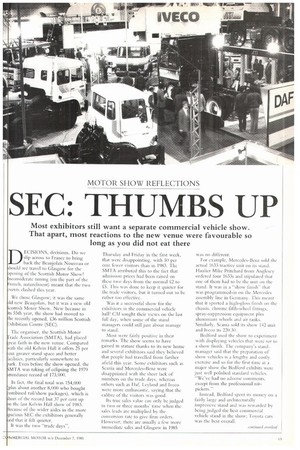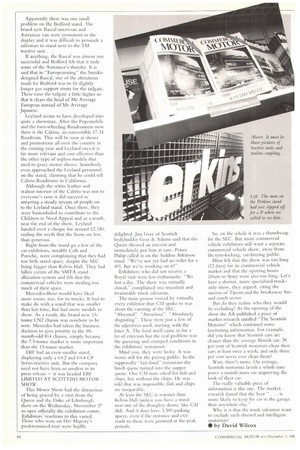SEC: THUMBS UP
Page 67

Page 68

If you've noticed an error in this article please click here to report it so we can fix it.
Most exhibitors still want a separate commercial vehicle show. That apart, most reactions to the new venue were favourable so long as you did not eat there
DECISIONS, decisions. Do we slip across to France to bring back the Beaujolais Nouveau or honk] we travel to Glasgow for the -)pening of the Scottish Motor Show? Inconsiderate timing (on the part of the French, naturelment) meant that the two .vents clashed this year.
We chose Glasgow; it was the same Ad new Beaujolais, but it was a new old icottish Motor Show. New because in ts 55th year, the show had moved to he recently opened, .06 million Scottish xhibition Centre (SEC).
The organiser, the Scottish Motor frade Association (SMTA), had placed ;reat faith in the new venue. Compared Nith the old Kelvin Hall it offers 25 per :ern greater stand space and better -acilities, particularly somewhere to )ark. Even before the show opened, the SMTA was taking of eclipsing the 1979 mendance record of 173,000.
In fact, the final total was 154,000 plus about another 8,000 who bought :ombined rail/show packages), which is ,hort of the record but 37 per cent up n the last Kelvin Hall show of 1983.
Because of the wider aisles in the more pacious SEC the exhibitors generally aid that it felt quieter.
It was the two "trade days",
Thursday and I;riday in the first week, that were disappointing, with 50 per CCM fewer visitors than in 1983. The SMTA attrihuted this to the fact that admission prices had been raised on these two days from the normal i2 to 5. Allis was done to keep it quieter for the trade visitors, but it turned out to be rather too effective.
Was it a successful show for the exhibitors in the commercial vehicle ball? CM sought their views on the last full day, when some of the stand managers could still just about manage to stand.
Most were fairly positive in their remarks. The show seems to have gained in stature thanks to its new home and several exhibitors said they believed that people had travelled from further afield this year. Sonic exhibitors such as Scania and Mercedes-Benz were disappointed with the sheer lack of numbers on the trade days, whereas others such as Dar, Leyland and Iveco were more enthusiastic, saying that the calibre of the visitors was good.
Its true sales value can only be judged in two or three months' time when the sales leads are multiplied by the conversion rate to give firm orders. However. there are usually a few more immediate sales and Glasgow in 1985 was no different.
For example, Mercedes-Benz sold the actual 1633 tractive unit on its stand. Haulier Mike Pritchard from Anglesey ordered tbur 1633s and stipulated that one of them had to be the unit on the stand. It was in a "show finish" that was programmed-in on the Mercedes assembly line in Germany. This meant that it sported a high-gloss finish on the chassis, chrome fifth-wheel fittings, spray-suppression equipment plus aluminium wheels and air tanks. Similarly, Scania sold its show 142 unit and Iveco its 220.30.
Bedford used the show to experiment with displaying vehicles that were nor to a show finish. The company's stand, manager said that the preparation of show vehicles is a lengthy and costly exercise and so for the first time at a major show the Bedford exhibits were just well polished standard vehicles. "We've had no adverse comments, except from the professional nitpickers."
Instead, Bedford spent its money on a fairly large and architecturally impressive stand and was rewarded by being judged the best commercial vehicle stand in the show; Toyota cars was the best overall. Apparently there was one small problem on the Bedford stand. The brand new Rascal microvan and Astramax van were prominent in the display and it was difficult to persuade a salesman to stand next to the TM tractive unit . .
If anything, the Rascal was almost too successful and Bedford felt that it stole some of the Astramax's thunder. It is said that in "Europeanising" the Suzukidesigned Rascal, one of the alterations made by Bedford was to fit slightly longer gas support struts for the tailgate. These raise the tailgate a little higher so that it clears the head of Mr Average European instead of Mr Average Japanese.
Leyland seems to have developed into quite a showman. After the Popemobile and the two-wheeling Roadrunners now there is the Cabrio, its convertible 17.34 Roadtrain. This will be seen at shows and promotions all over the country in the coming year and Leyland says it is far more relevant and cost effective than the other type of topless models that used to grace motor shows. Somebody even approached the Leyland personnel on the stand, claiming that he could sell Cabrio Roadtrains in California.
Although the white leather and walnut interior of the Cabrio was not to everyone's taste it did succeed in attracting a steady stream of people on to the Leyland stand. Once there, they were buttonholed to contribute to the Children in Need Appeal and as a result, near the end of the show, Leyland handed over a cheque for around 2,150, ending the myth that the Scots are less than generous.
Right from the word go a few of the car exhibitors, notably Colt and Porsche, were complaining that they had too little stand space, despite the SEC being bigger than Kelvin Hall. They had fallen victim of the SMTA stand allocation system and felt that the commercial vehicles were stealing too much of their space.
Mercedes-Benz would have liked more room, too, for its trucks. It had to make do with a stand that was smaller than last time, but had inure models to show. As a result, the brand new 13tonne LN2 chassis was nowhere to he seen. Mercedes had taken the business decision to give priority to the 18month-old 814 chassis, simply because the 7.5-tonne market is more important than the 13-tonne market.
ERF had an even smaller stand, displaying only a 6x2 and 6X4 CP Series tractive unit. But the company need not have been so modest in its press release — it was headed ERF LIMITED AT SCOTTISH MOTOR SHOW.
This Motor Show had the distinction of being graced by a visit from the Queen and the Duke of Edinburgh, there on the Wednesday, November 27 to open officially the exhibition centre. Exhibitors' reactions to this varied. Those who were on Her Majesty's predetermined tour were highly delighted. Jim Gray of Scottish bodybuilder Gray & Adams said that the Queen showed an interest and immediately put him at ease. Prince called in on the Seddon Atkinson stand. "We've not yet had an order for a 401, but we're working on it!"
Exhibitors who did not receive a Royal visit were less enthusiastic. "We lost a day. The show was virtually closed," complained one truculent and treasonable truck salesman.
The main grouse voiced by virtually every exhibitor that CM spoke to was about the catering at the SEC. "Abysmal". "Atrocious". "Absolutely disgusting". These were just a few of the adjectives used, starting with the letter A. The food itself came in for a lot of criticism hut the real problem was the queueing and cramped conditions in the exhibitors' restaurant.
Mind you, they were lucky. It was worse still for the paying public. In the supposedly "fast food" restaurant the lunch queue turned into the supper queue. One CM man asked for fish and chips, but without the chips. He was told that was impossible; fish and chips are inseparable.
At least the SEC is warmer than Kelvin Hall (unless you have a stand near one of the draughty doors, like CM did). And it does have 3,500 parking spaces, even if the entrance and exit roads to these were jammed at the peak periods.
So, on the whole it was a thumbs-up for the SEC. But most commercial vehicle exhibitors still want a separate hi ye....C..e 8..0w, away from
commercial h the tyre-kicking, car-buying public. Most felt that the show was too long (12 days) for its commercial vehicle market and that the opening hours (10am to 9pm) were also too long. Let's have a shorter, more specialised truckonly show, they argued, citing the success of Tipcon and the breakaway bus and coach sector.
But do they realise who they would be excluding? At the opening of the show the AA published a piece of market research entitled "The Scottish Motorist" which contained some fascinating information. For example, did you know that Scottish cars are cleaner than the average British car; 38 per cent of Scottish motorists clean their cars at least once a week; and only three per cent never ever clean them?
Wait, there's more. On average, Scottish motorists lavish a whole nine pence a month more on improving the look of their car.
The really valuable piece of information is this one. The market research found that the Scot " . is more likely to keep his car in the garage than anywhere else."
Why is it that the truck salesmen want to exclude such shrewd and intelligent motorists?
• by David Wilcox




































































































